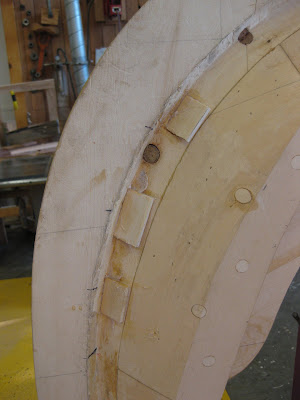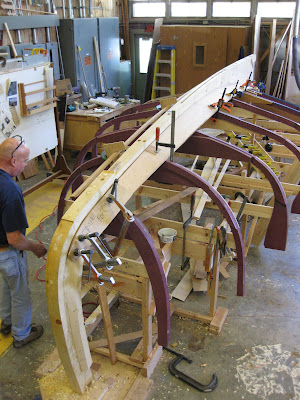
Here you see one of the engine beds being fit. The auxilliary floor timbers were cut away and beveled to fit the bottom (top in the picture) of the engine beds. The top edge is cut at an angle to match the orientation of the engine.

One of the reasons we're installing these engine beds now is because they are going to be bolted through the floor timbers. If we don't get them installed now, we'll have to drill through the planking, and the fewer holes through the planking the better.

Here you see the starboard side engine bed fit.

And the port side one is waiting for final fitting. Once it's fit, we can bolt them in and we'll be ready to fasten our garboard planks.

Fairing is continuing over on the port side.

Most of the material has been removed here at the forefoot, so we're getting really close.

And back aft, we've just got the inner keel and the adjacent floor timbers and sawn frames left to finalize.

Over on the starboard side we've had to fit a few patches where the rabbet ended up a little deeper than we wanted. It's important to have good contact between the back rabbet and the plank, so we're epoxying in a few pieces to fill these potential voids.

Once the epoxy has cured, we can plane down these pieces to match the surrounding rabbet. And with that complete, we're ready to begin planking.

There are a couple of steps before we're actually hanging planks. Since our first plank (the garboard) is defined along one edge by the rabbet, it's a good idea to make a pattern for that entire edge of the plank. Patterning a plank is what's know as spiling.
It takes a little time to make a full pattern for the rabbet edge, but a good fit will be worth the extra effort here. The trickiest section of the plank to pattern is here at the forefoot, where the plank is twisting into the rabbet. As mentioned last week, here the horizontal rabbet of the keel transitions into the vertical rabbet of the stem. We'll be asking the plank to take quite a twist as it bends. But we ask our 1/4" plywood pattern to do it first.

Not only does the garboard need to fit into the rabbet, but it also needs to fit against the cheek piece. After a little fitting, you can see here that the pattern fits tightly against the cheek piece. Hopefully the finished plank will do the same.

As we move aft, lets take a look at how we make our pattern. We start with a spiling batten, usually a piece of thin plywood.

There are may ways of scribing when making a pattern. The method we'll use here is called a compass scribe. Where the name comes from is pretty obvious from the next picture. To pattern the line (in this case the rabbet) use the compass to draw an arc on the spiling batten. The radius of the arc doesn't matter, so long as the arc fits on your batten and isn't so small that it becomes difficult to draw. One important thing to remember is not to change the radius on your compass while making your pattern. The reason for this will become evident in a minute.

Once you have arc every few inches defining the line your scribing, transfer the spiling batten to your stock. In most cases you'd go from the spiling batten directly to your planking stock, but since we're making a full pattern, we're still using patterning stock. With the point of the compass now on the arc drawn on the batten, make an arc on the pattern stock.

Now set the point of the compass at another point along the same arc on the spiling batten, and make another arc on your pattern, crossing the first. The point where these two arcs intersect is the point along the rabbet we scribed originally. Unless the radius on your compass has changed. Then who knows what you'll get.

Once this point is established, drive a nail and move on to the next point.

Once points have been establish the entire length of the rabbet, we use a batten to connect them and draw our line.

And now we have our rabbet line scribed onto our pattern. Now we just have to cut along the line and finish it off with a little planing.

Once the pattern is complete, it's time to make our plank. After milling the planking stock to the correct thickness, we lay the pattern on and transfer our lines. Since we took the time to make a full pattern along the rabbet, the bottom edge of the plank is easy enough to draw. We're simply tracing our pattern.

For the top edge of the plank, we established the edge of the plank at each of frames based on the plank lines we drew last week. So for the top edge, we'll use a batten to connect these point to get our line.

Once we've got the plank drawn, we cut it out and finish the edges with a plane.

And there you have it: our garboard plank. See what I mean about the shape of the plank? The far end which looked straight on the boat now has a definite curve to it.

With the plank ready for some final fitting, we first have to bend it to that shape at the forefoot. So it's off to the steam box for our plank. Thankfully the twist is only at the forward end of the plank, because as it turns out, our steam box isn't quite long enough for the whole plank.
After an hour of steaming, the plank took the bend without much difficulty. We've got it bent into position here and we didn't hear any of the telltale sounds of it breaking. We backed up the plank with a piece of thin plywood to help prevent the plank from splitting out and also to protect the soft red cedar from the clamps.

Underneath it looks pretty good.

Not too bad back aft either.

We'll leave the plank clamped like this over the weekend, so when we come back on Monday the plank will maintain the twist when we remove the clamps. We'll still have some fitting left to do, but we should have this one ready to fasten on before long.

It's only the first of the twenty planks we'll be hanging before the hull is complete, but it's still quite exciting to see it on the boat.

No comments:
Post a Comment